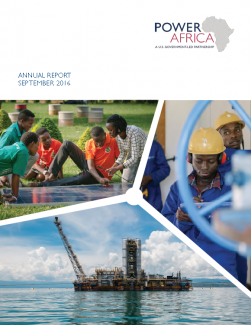In June 2013, President Obama launched Power Africa with the ambitious goal of doubling access to electricity in sub-Saharan Africa.
Power Africa is a U.S. Government-led initiative, coordinated by the U.S. Agency for International Development (USAID), that comprises 12 U.S. Government agencies, and a diverse coalition of more than 130 public and private sector partners, including bilateral and multilateral partners, as well as international organizations, civil society organizations, and private sector companies. In its first three years, Power Africa has built the foundation of an innovative development model that focuses on supporting “first-of-their-kind” transactions that create pathways for future transactions to move forward. Power Africa also prioritizes unlocking and accelerating transactions by removing barriers and building a more investment-friendly enabling environment.Through this model, Power Africa is leading a major international effort to develop new power generation capacity and connect millions of households and businesses to on-grid and offgrid power across sub-Saharan Africa.
The Power Africa Roadmap, released in January 2016, lays out our strategy for doubling access to power across sub-Saharan Africa by adding 60 million new electricity connections, as well as increasing installed generation capacity by 30,000 MW by 2030.1 The Roadmap outlines Power Africa’s three strategic pillars: Generation, Connections, and Unlocking Energy Sector Potential. These three pillars help our partners to accelerate energy transactions by working with African governments to create the policy, legal, and regulatory frameworks needed to attract private sector investment in the energy sector. Alongside the Roadmap, Power Africa also launched the Power Africa Tracking Tool (PATT), an online and mobile application that allows users to easily track power sector development and transactions across the continent.Through the PATT, much of this transaction data is being made publicly available for the first time, increasing transparency and better informing investors on opportunities.
In February 2016, the Electrify Africa Act of 2015 passed by unanimous consent in both chambers, a testament to the bipartisan and bicameral leadership in Congress in advancing solutions to pressing development issues. The legislation states that it is the policy of the United States to promote first-time access to power for at least 50 million people and to encourage the installation of at least 20,000 additional MW of electrical power in sub- Saharan Africa by 2020. On February 8, 2016, President Obama signed the Electrify Africa Act of 2015 (S.2152) into law, institutionalizing the work of Power Africa through legislation and signaling to the global community that expanding electricity access in sub-Saharan Africa is a longterm foreign policy priority of the U.S. Government. The Electrify Africa Act, whose goals are broadly consistent with Power Africa, validates the work and approach that Power Africa has already undertaken to address energy poverty, and ensures that the transformative progress we are making will continue beyond this Administration. In August 2016, Power Africa released the Electrify Africa Act Report, which complements the Power Africa Roadmap and entails a comprehensive multiyear strategy for how the United States intends to achieve the goals of addressing sub-Saharan Africa’s energy crisis in areas such as increasing and improving power generation, transmission, and distribution; increasing first-time access to electricity; reforming policy, regulatory, and power sector governance; and increasing affordability and non-discriminatory access to power.
After three years of operation, Power Africa has helped facilitate the financial close of private sector power transactions that are expected to generate over 4,600 MW. Power Africa is currently tracking approximately 60,000 MW of generation projects across the continent, which we recognize is just a subset of all generation projects proposed or underway. Based on the realities of capital projects, our experience in sub-Saharan Africa, and the best available information we have today, we expect that between 18,000 – 21,000 MW of the 60,000 MW we are tracking will reach financial close and are expected to be online by 2030. In the past year, Power Africa grew the number of its field-based transaction advisors in sub-Saharan Africa to over 40 experts who are helping the private sector and governments prioritize, coordinate, and expedite the steps necessary for the implementation of these power projects. Our transaction advisors are also working with our partners to help us identify new viable projects to fill the gap of 9,000 – 12,000 MW to reach our 30,000 MW goal.

